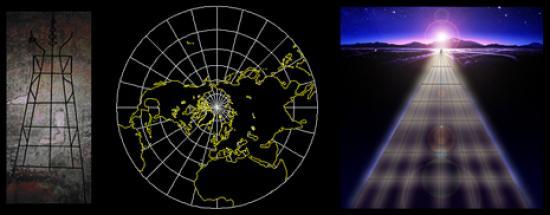The Rosslyn Matrix by Ashley Cowie
16th August 2006

Kath Gourlay Writes.....
Just when you think there can't be anything left to dig up when it comes to secret codes and Rosslyn Chapel, another layer is unearthed. The latest mystery - involving a carving scratched on the wall of the crypt - doesn't involve the Knights Templar, the bloodline of Christ, or any ancient secret societies. But for Ashley Cowie - who has spent the best part of a decade trying to work out its meaning - the carving has huge global significance for Scotland when it comes to the history of ancient navigation. 'What is down there is an example of a lost system for measuring time and distance, involving both latitude and longitude. It's a priceless mapping treasure.'
This navigational teaching board forms the basis of a new book, "The Rosslyn Matrix" where Cowie presents his case for Rosslyn Chapel being less cryptic and more cartographic. At first glance, the mysterious carving looks a bit like a miniature electricity pylon or an oil drill with a latticed construction of uprights and grids. At the top is the outline of a misshapen cup which has a five pointed star on one of the sides. Inside the cup shape, stacked on top of each other, are four diamond shaped lozenges of different lengths and widths.
The crypt is part of an older building the 15th century chapel was built on top of, and it had been used as a workshop during chapel construction. The scratching on the south wall seems to have been dismissed as a workman's sketch for one of the roof pinnacles. 'I can say with confidence this carving does not represent a pinnacle, or any three dimensional church spire design,' says Cowie. 'This becomes obvious when you break down the elements of the carving and unravel the geometric layers.'
Which is where he has the edge on most of us.
Where we see an electricity pylon or a badly drawn cup, Cowie sees a multi-layered, geometrically defined, mathematical template. And that's just one carving. Before he gets down to the nitty gritties, the first forty pages of his book colourfully illustrate - with graphic precision - his analysis of what he believes Rosslyn Chapel is not. 'It is not a copy of Solomon's or Herod's Temple. There is no 'Grail Trail' link with a Jerusalem based meridian, and mathematical analyses of original ground plans show it to be an unfinished collegiate church.'
Not a knight in sight�
'I challenge anybody to show me a Knight Templar symbol in there' he says - no doubt opening up a very big can of worms. 'Rosslyn has nothing to do with Freemasonry either', he claims - 'such concepts are illusions performed by modern authors and distract us from the real reasons such places were built' - his new book completely ignores such ideas.
Cowie speaks with the righteousness of the newly converted. 'Yes, I went down all the usual roads and got involved with all the esoteric stuff, Knights Templar included. I've come out the other end with my feet now firmly on terra firma.'
A decade and more has passed since the young fish merchant with a love of local history first brushed the dirt off an old crest on a ruined Caithness farmhouse lintel. Researching into the background of what turned out to be the engrailed cross of the St Clairs, led to a fascination with the skills of the family of ancient master builders and their craftsmen.
Determined to remain unfazed by the current hype, he examined William St Clair's fifteenth century Rosslyn Chapel from a practical perspective. 'As Earls of Orkney and Caithness, William and his predecessors learned their navigational skills from their Norwegian overlords who were experienced explorers.' The carving is what he believes to be the Chapel's most enduring legacy. If correct, it must surely make a hugely important contribution to Scottish scientific history.
Getting him to explain its importance in a few short paragraphs is impossible, and the following synopsis will no doubt cause him much angst�
The lozenges at the top are ancient symbols showing degrees of latitude. They're based on shadows recorded at solstice sunrises and sunsets producing different shapes at each degree of latitude. Tall, thin lozenges relate to northern places like Norway, which the top lozenge on the carving represents; wide and squat signifies a Mediterranean band, as in the bottom one. The middle two lozenges are the latitudes for Orkney (northern Scotland) and Rosslyn (southern Scotland).
The pylon shaped grid is a longitudinal slice of 15 degrees (1/24th of the 360 degree globe) and its vertical central line is an ancient meridian. And the cup shape isn't a cup, or grail chalice. It's an astronomical drawing of the orbits traced by the morning and evening star, a.k.a. planet Venus. All the elements in the carving were important to ancient navigators for synchronising dates, times and locations.
Cowie has certainly opened up many new avenues of approach, where a rich heritage and long standing cultural tradition take the place of myth and magic.
And Rosslyn Chapel are very happy to stock 'The Rosslyn Matrix' on their shelves. 'It's an interesting and refreshing new perspective on Rosslyn,' says Stuart Beattie, Project Leader of the Chapel Trust. 'And we're currently selling signed copies of the book to visitors'.
Ashley will be delivering a lecture about his book and doing a signing at the Orkney International Science Festival on September 5th . The festival organisers are advising people to get there early to assure a seat. With a series of three books on their way, a signed copy of Cowie's first book might just be a very good investment.
The book is avaliable in DR Simpson, Jim Bews and the Orkadian book shop.
See the web site
www.rosslynmatrix.com



